
The islands and islets of Mono Lake are important nesting sites for California Gulls.
Gulls’ fate intertwined with Mono’s lake level
“Mono Lake’s gulls are in dire and immediate danger. Coyotes, rabbits and mice have crossed a newly exposed landbridge to Negit Island, jeopardizing the survival of 38,000–40,000 breeding California Gulls, the largest known colony in the world. The arrival of predators will doom the island’s gulls.”
–David Gaines, 1978
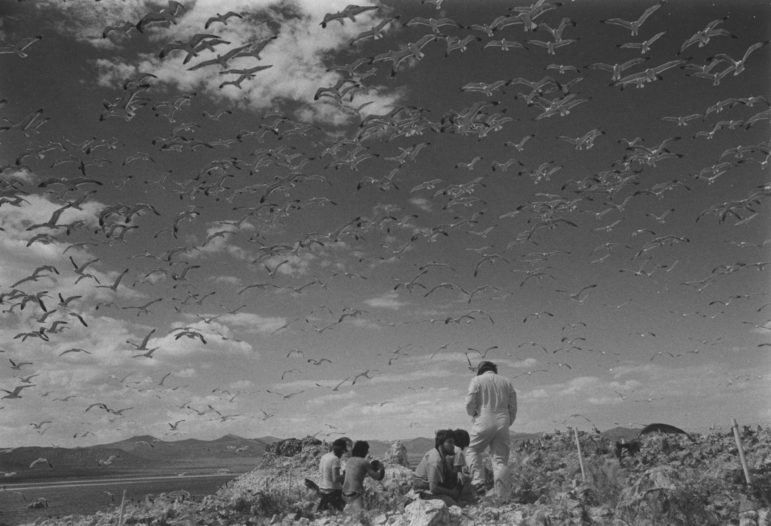
Gaines wrote this grim warning in the Mono Lake Committee’s third newsletter in autumn 1978. The preceding year, Mono Lake’s level had dropped so low that Negit Island was connected to the mainland by a landbridge, and opportunistic coyotes had crept onto the island to prey on nesting gulls and their chicks. As the Los Angeles Department of Water and Power continued to divert water from Mono Lake’s tributary streams and the lake level continued to drop, the fate of the California Gull colony at Mono Lake seemed hopeless.
Approximately 25% of the global population of California Gulls nests at Mono Lake, so destruction of their nesting grounds on Mono Lake’s islands poses a significant threat to the species. Even a single predation event by coyotes can cause a long-term impact, because gulls remember the disruption and will become suspicious of returning to nesting sites where they were hunted. Dropping lake level also poses a threat to the gulls’ food sources: without fresh water entering the lake from its tributary streams, the lake’s salinity rises, making the water inhospitable to alkali flies and even the brine shrimp.
Early protection efforts, 1970s–1990s
The ongoing threat of predation from coyotes motivated a number of different approaches to protection of the California Gulls’ nesting grounds, including blasting a moat, steel fencing, and electric fencing. But the most important, and most lasting, protection continues to be the rising lake level–thanks to the 1994 ruling that limited water diversions to Los Angeles–that keeps Mono Lake’s islands and islets separated from the mainland by deep water.
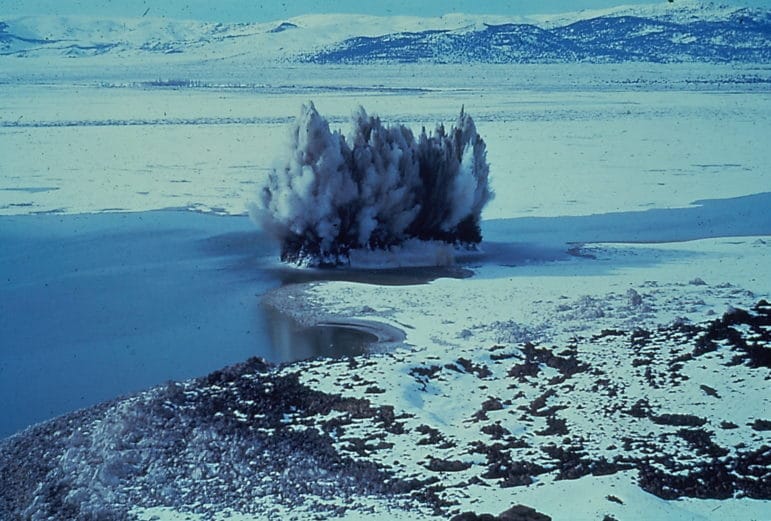
Landbridge blasting, 1978
The first attempt to protect the Negit Island nesting grounds was also one of the first tasks of the Mono Lake Committee: by facilitating a partnership between the Committee, the Audubon Society, the California Department of Fish and Game, and the Bureau of Land Management, the groups engaged the California National Guard to blast through the shallow channel between Negit and the mainland.
The blasting effort was partly successful. It deepened the channel and prevented coyotes from reaching Negit in 1978, but in 1979 not a single gull chick survived to adulthood–all were killed by coyotes that had again crossed the landbridge as the lake level continued to drop. A different approach would be needed.
Steel chain-link fencing, 1980
In January 1980 the California state legislature appropriated funds to the Department of Fish and Game for the protection of the gulls, and in early spring a half-mile of steel chain-link fencing was installed across the landbridge to protect gulls on Negit.
The gulls did not return to Negit Island, however, remembering the years of devastation there. They instead crowded onto other nearby islets, but suffered because of lack of food–the salinity of the lake had risen so much that alkali flies and brine shrimp were dying off, too.
A series of wet winters in the late 1980s were a reprieve for Mono Lake’s ailing ecosystem, as DWP was unable to divert all the runoff from the tributary creeks. The gulls rebounded and recolonized Negit, which was again an island.
But by the early 1990s a drought had gripped the Sierra, and the lake level had dropped precipitously again. The landbridge to Negit was re-emerging
Recent protection efforts, since 2015
Even as Mono Lake continues to rise toward the management level, only a few years of drought could again imperil the California Gulls, and a changing climate and ecosystem present new challenges for the Committee and partners.
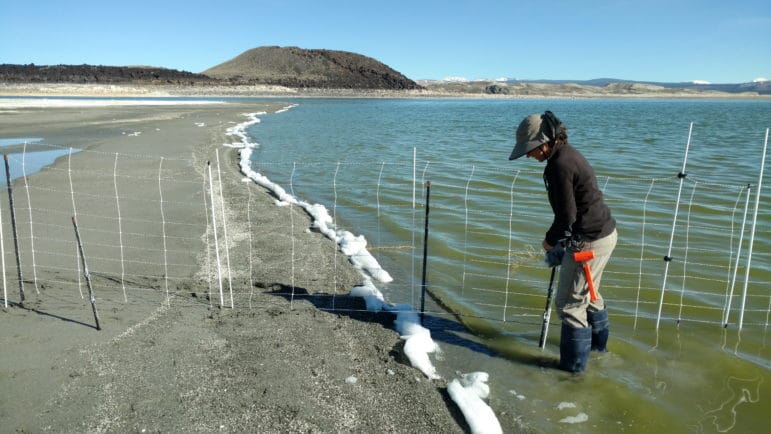
Electric fencing funded by Mono Lake Committee members, 2017
Five years of persistent and severe drought lowered the level of Mono Lake by more than seven vertical feet, so that Negit Island and adjacent islets were again nearly connected to the mainland by a landbridge. In 2016 researchers discovered signs that coyotes had reached a few of the islets and preyed on gull eggs and chicks.
In response, the Mono Lake Committee worked to model several different scenarios for precipitation and runoff in order to understand the conditions that might require extra protection for the gulls. It became clear that the gull rookery would be in serious danger in the spring, even after the exceptionally wet winter of 2016-2017, because the runoff wouldn’t raise the lake above the threshold of concern until well into nesting season.
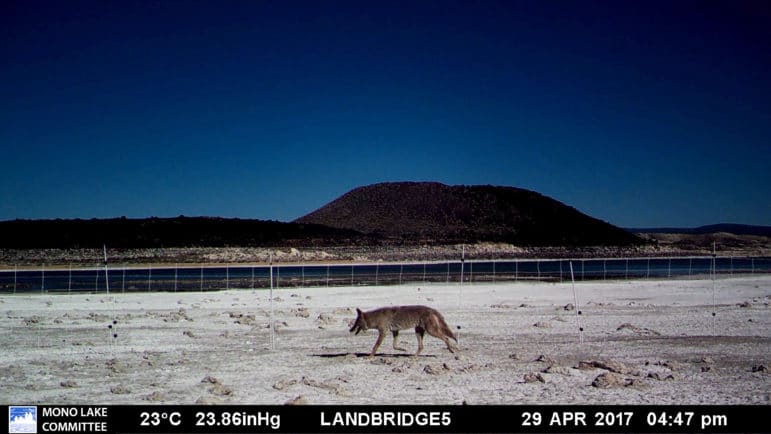
The Committee, together with California State Parks and other partner agencies, made a plan to erect a temporary electric fence along the landbridge to stop coyotes from being able to access the gull nesting grounds. The solar-powered, electrified mesh fencing we hoped to use was expensive, and we’d need about a mile of it. A generous donation from a thoughtful member in February 2017 kick-started a crowdfunding effort, and $15,460 later, the #LongLivetheGulls campaign had raised enough from members and Mono-phile friends to purchase the fencing and install it ahead of the gulls’ April arrival to their nesting grounds.
The fence installation proved to be an effective plan: wildlife cameras captured coyotes patrolling the fenceline in late April, however, no coyote tracks were observed on the gulls’ side of the fence, and the nesting season proceeded undisturbed. As the lake level rose and the California Gull chicks fledged, the fencing was removed and stored.
Managed burn of invasive weeds, 2020
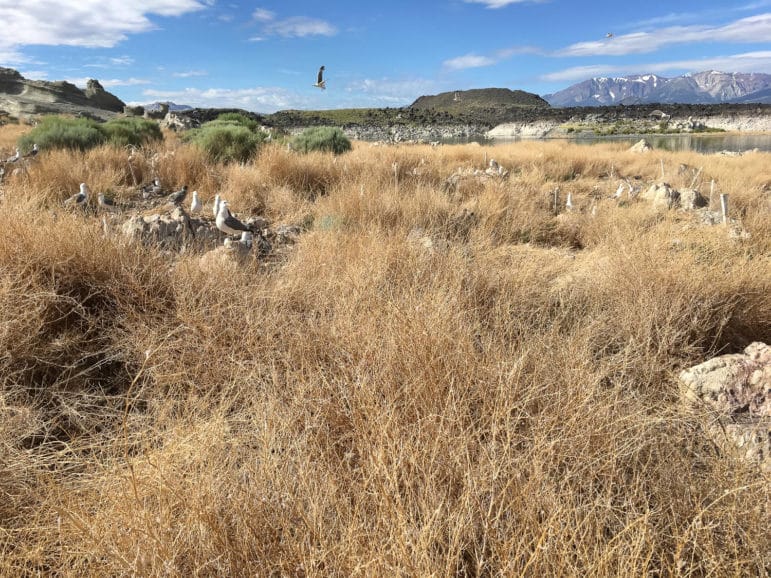
In 2016, the sudden appearance and rapid expansion of the invasive weed Bassia hyssopifolia added a new pressure to the nesting colony of California Gulls at Mono Lake. Bassia colonized huge swaths of Twain Islet and surrounding islets slets, leaving little bare ground for gulls to build their nests.
The Mono Lake Committee partnered with the Inyo National Forest to combat the emergent weed problem, and the Inyo, together with California State Parks and Point Blue Conservation Science, agreed to conduct a controlled burn on Twain Island. Planning for the burn commenced in 2017, but weather conditions didn’t cooperate, and the operation was postponed. In 2018 it was delayed again.
In 2019, the annual survey of gull nests turned up the fewest ever recorded–biologists were witnessing a precipitous drop since 2016 that they attributed to the Bassia spread. The controlled burn became a higher priority for everyone, and in February of 2020, a mild winter and calm weather provided the perfect conditions.
The Mono Lake Committee’s new research boat ferried workers and equipment to Twain Islet over the course of several days, and the controlled burn was successfully executed by Inyo National Forest firefighters. After all the Bassia had been torched, Committee staff sprayed lake water on an experimental plot to see if the alkaline water would prevent seed germination.
Early results of the controlled burn are extremely promising. A visit to the island in August 2020 verified that Bassia had been nearly eradicated; few new plants were growing.
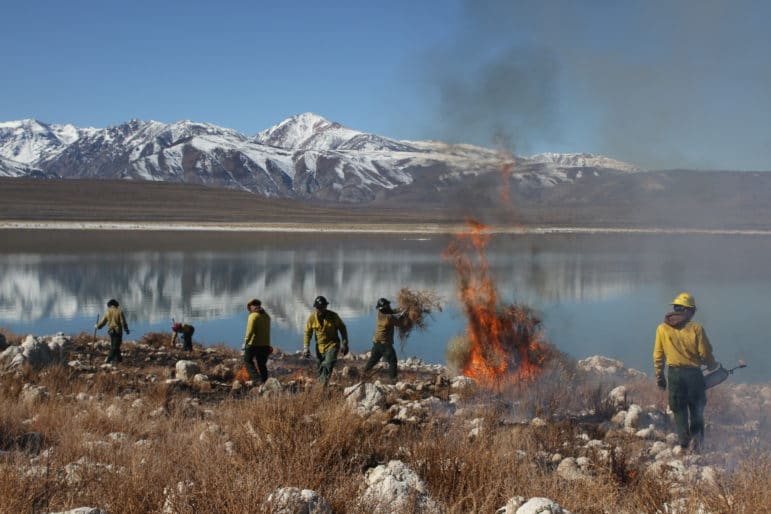
Long Live the Gulls
To learn more about recent efforts to protect Mono Lake’s gull colony from the invasive weed Bassia, check out the blog, or the related resources below.
RELATED RESOURCES: California Gulls return to nest on Mono Lake islet after prescribed burn | A burning solution to the Bassia problem | Smoke signals good news for Mono Lake’s California Gulls
Top photo by Judy Bellah.
